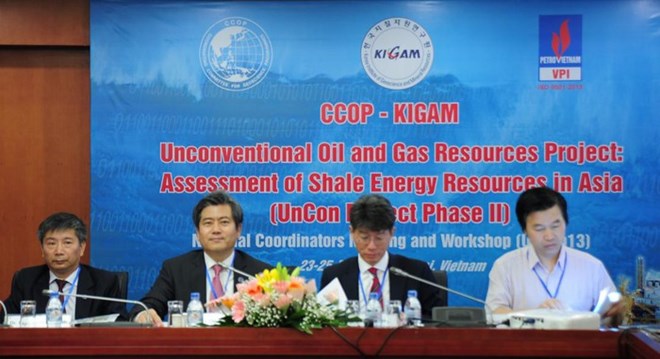Asian countries cooperate to assess potential of shale oil and gas resources
An international workshop on the assessment of shale energy in Asia, under the second phase of the unconventional oil and gas resources project, took place in Ha Noi on 23 April.
 |
| Delegates at the workshop (Source: www.baohomnay.com) |
The event was jointly held by the Coordinating Committee for Geoscience Programmes in East & Southeast Asia (CCOP), the Korea Institute of Geoscience and Mineral Resources (KIGAM), and the Viet Nam Petroleum Institute (VPI).
Dr. Byeong-Kook Son, head of KIGAM’s oil and gas research group, introduced the results of the assessment in 13 sedimentary basins and 21 shale formations in Asia.
He cited the latest update of the shale oil and gas reserves in Asian countries as follows: Malaysia 8.19 trillion cubic feet (TCF) (equivalent to 232 billion cu.m); the Philippines 149.8 TCF (4,242 billion cu.m), Viet Nam 77 TCF (2,180 billion cu.m), Indonesia 58.12 TCF (1,646 billion cu.m), the Republic of Korea 72.5 TCF (2,053 billion cu.m), and Laos 51 TCF (1,444 billion cu.m).
Prof. Dr. Azara N.Tucuncu, from the US-based Unconventional Natural Gas and Oil Institute (UNGI)’s petroleum engineering department, said the research and exploitation of non-traditional resources like shale oil and gas require huge costs.
He suggested that the Vietnamese Government put forth specific policies to support oil and gas companies, such as the Viet Nam Oil and Gas Group (PetroViet Nam or PVN).
PVN could also collaborate with foreign partners in the field, he recommended.
According to Dr. Trinh Xuan Cuong, deputy director of the VPI, his institute is cooperating with domestic and foreign partners to carry out long-term research programmes on unconventional oil and gas.
The VPI is conducting research on the characteristics and prospects of gas hydrates in the East Sea, shale oil and gas in sedimentary basins on the continental shelf of Vietnam, and coal-bed methane in Ha Noi, Thanh Hoa-Nghe An, and Tuy Hoa.
(Source: VNA)